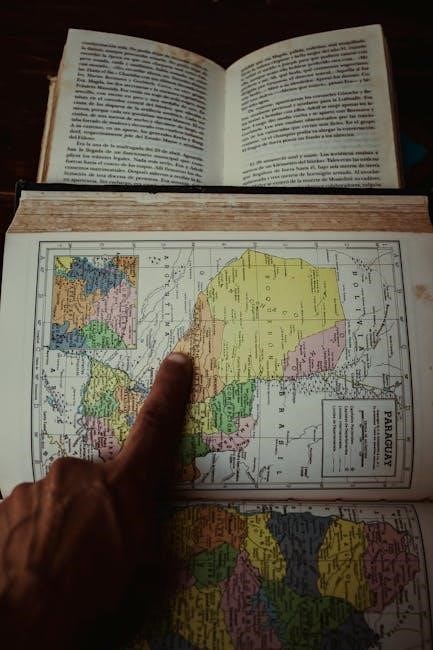The AP World History Exam‚ offered by the College Board‚ is a rigorous college-level assessment designed to evaluate students’ critical thinking and historical knowledge.
It features multiple-choice and free-response sections‚ assessing mastery of historical concepts and skills. Recognized by universities worldwide for credit and advanced placement‚ it’s a key component of the AP Program.
1.1 Overview of the Exam Structure
The AP World History Exam is divided into two main sections: Section I (Multiple-Choice Questions) and Section II (Free-Response Questions). Section I includes 55 multiple-choice questions‚ while Section II comprises short-answer‚ essay‚ and document-based questions. The exam assesses students’ knowledge of historical periods‚ themes‚ and regional perspectives. It evaluates critical thinking‚ analytical skills‚ and the ability to construct well-supported arguments. The structure is designed to reflect the course curriculum and prepare students for college-level rigor.
1.2 Importance of the Exam for College Credit
Earning a qualifying score on the AP World History Exam can grant students college credit‚ advanced placement‚ or both. This allows students to bypass introductory courses‚ saving time and tuition. Many universities recognize AP scores‚ providing a competitive edge for students. The exam is a standardized measure of college readiness‚ ensuring fairness and consistency. High scores demonstrate mastery of college-level material‚ making it a valuable asset for academic advancement and future opportunities.
1;3 Brief History of the AP Program
The Advanced Placement Program was established in the 1950s to provide high school students with the opportunity to pursue college-level coursework. The first AP exams were administered in the late 1950s‚ initially covering a limited range of subjects. Over the decades‚ the program expanded significantly‚ now offering 38 subjects‚ including World History. The program has grown to become a cornerstone of academic rigor‚ enabling students to earn college credit and advanced placement. This initiative reflects a commitment to preparing students for higher education and beyond.

Exam Format and Timing
The AP World History Exam consists of multiple-choice and free-response sections‚ totaling 3 hours and 15 minutes‚ designed to assess historical knowledge and critical thinking skills effectively.
2.1 Section I: Multiple-Choice Questions
Section I of the AP World History Exam features 55 multiple-choice questions‚ lasting 55 minutes. Each question targets specific historical periods‚ themes‚ or thinking skills. Students analyze primary sources‚ maps‚ or historical data to select the correct answer from four options. This section assesses factual knowledge‚ interpretive skills‚ and the ability to contextualize historical events. The format emphasizes critical thinking and application of historical concepts‚ ensuring a comprehensive evaluation of a student’s understanding of global history.
2.2 Section II: Free-Response Questions
Section II consists of free-response questions‚ including a document-based question (DBQ) and two evidence-based essays. Students have 90 minutes to complete this section‚ which evaluates their ability to analyze historical sources‚ develop arguments‚ and apply historical thinking skills. The DBQ requires the use of provided documents to construct a coherent essay‚ while the essays test knowledge of specific historical periods or themes.
These questions emphasize critical thinking‚ contextualization‚ and synthesis of historical information‚ ensuring students demonstrate a deep understanding of global history and its complexities.
2.3 Timing and Exam Duration
The AP World History Exam lasts approximately 3 hours and 15 minutes. Section I‚ the multiple-choice portion‚ is 55 minutes‚ while Section II‚ the free-response questions‚ is 90 minutes. A 5-minute break is included between sections. The exam is designed to assess both knowledge and critical thinking skills within a structured timeframe‚ ensuring students manage their time effectively to complete all parts of the test successfully.

Exam Content and Curriculum Framework
The AP World History Exam covers a broad curriculum framework‚ focusing on key historical periods‚ regional studies‚ and the development of global civilizations and their interactions.
3.1 Key Concepts and Learning Objectives
The AP World History Exam emphasizes critical thinking‚ evidence-based arguments‚ and historical analysis. Key concepts include cultural exchange‚ empires‚ technological progress‚ and global interactions. Learning objectives focus on students’ ability to analyze primary sources‚ compare historical events‚ and synthesize information across different regions and time periods‚ ensuring a comprehensive understanding of global history and its relevance to contemporary issues.
3.2 Historical Periods and Regional Focus
The AP World History Exam covers six historical periods: Foundations (to 600 BCE)‚ Classical (600 BCE–600 CE)‚ Medieval (600–1450 CE)‚ Early Modern (1450–1750 CE)‚ Modern (1750–1900 CE)‚ and Contemporary (1900–present). The curriculum emphasizes regional diversity‚ including Afro-Eurasia‚ the Americas‚ and Oceania. Students analyze global interactions‚ cultural exchanges‚ and historical developments across these regions and periods‚ fostering a nuanced understanding of interconnectedness and change over time.
3.4 Skills Assessed in the Exam
The AP World History Exam evaluates critical thinking‚ historical analysis‚ and writing skills. Students must demonstrate the ability to analyze primary sources‚ compare historical events‚ and construct coherent arguments. The exam assesses skills in contextualization‚ evidence-based reasoning‚ and synthesis of information. These competencies are essential for college-level coursework and are developed through engaging with diverse historical perspectives and themes.

Sample Exam Questions and Practice Materials
Sample questions and practice materials for the AP World History Exam are available online‚ offering insights into exam structure and content alignment with the curriculum framework.
4.1 Multiple-Choice Sample Questions
The multiple-choice section of the AP World History Exam assesses students’ ability to analyze historical themes and events. Sample questions are available online‚ reflecting the exam’s structure and content. These questions cover various historical periods and regions‚ testing critical thinking and comprehension. They align with the curriculum framework‚ addressing key concepts and learning objectives. Students can use these samples to familiarize themselves with the question format and improve their test-taking strategies. Practicing with these resources enhances exam readiness and understanding of the material.
4.2 Short-Answer and Essay Sample Questions
The short-answer and essay sections of the AP World History Exam require students to demonstrate analytical and writing skills. Sample questions are available in the official practice materials‚ showcasing the types of prompts students may encounter. These questions focus on historical reasoning‚ evidence-based arguments‚ and thematic connections. Scoring guidelines and sample student responses are provided to illustrate expectations. Practicing with these resources helps students refine their writing techniques and deepen their understanding of historical concepts and themes.
4.3 Accessing Official Practice Exams
Official practice exams for the AP World History Exam are available through the College Board website. These resources include past exam papers‚ scoring guidelines‚ and sample responses. Students can download PDF versions of previous exams to familiarize themselves with the format and content. Additionally‚ the College Board provides detailed instructions and mark schemes to help students understand how exams are graded. Accessing these materials is essential for effective preparation and understanding of the exam structure and expectations.

Scoring and Grading
The AP World History Exam uses a scoring scale of 1 to 5‚ with 5 being the highest. Scores reflect a student’s mastery of course content and skills; Official practice exams provide scoring guidelines to help students understand how their responses are evaluated. Understanding the grading criteria is crucial for achieving a high score and earning college credit.
5.1 Scoring Scale and Grade Distribution
The AP World History Exam is scored on a scale of 1 to 5‚ with 5 indicating exceptional mastery of content and skills. The majority of students typically score between 2 and 4‚ reflecting varying levels of understanding. Grade distribution varies annually but generally follows a bell curve‚ with a smaller percentage achieving a 5 and a larger percentage scoring a 2 or 3. Scores are determined by performance on both multiple-choice and free-response sections.
5.2 How the Exam is Graded
The AP World History Exam grading involves a combination of machine scoring for multiple-choice questions and expert evaluation for free-response sections. Each section is weighted‚ with multiple-choice contributing 40% and free-response 60%. Trained educators and college professors assess essays and short answers‚ using predefined rubrics to ensure consistency. Raw scores are then scaled to align with the 1-5 grading scale‚ reflecting a student’s overall performance relative to established standards and benchmarks.
5.3 Understanding Raw and Scaled Scores
Raw scores are calculated based on correct answers in multiple-choice and free-response sections‚ with penalties for incorrect or blank multiple-choice answers. These raw scores are then converted to scaled scores ranging from 1 to 5‚ adjusting for exam difficulty and ensuring fairness across administrations. Scaled scores reflect a student’s performance relative to predefined standards‚ with 3 considered qualified and 4-5 as highly qualified‚ impacting college credit eligibility and placement decisions.

Course and Exam Description (CED)
The Course and Exam Description (CED) is the official guide outlining the AP World History curriculum‚ learning objectives‚ and exam structure‚ ensuring alignment with College Board standards.
6.1 Overview of the CED Document
The Course and Exam Description (CED) provides a comprehensive overview of the AP World History course and exam. It includes detailed learning objectives‚ key concepts‚ and historical periods covered. The document also outlines the structure of the exam‚ including multiple-choice‚ short-answer‚ and essay questions. Additionally‚ it offers sample questions and scoring guidelines‚ ensuring clarity for both teachers and students. The CED aligns with College Board standards‚ making it an essential resource for effective preparation.
6.2 Key Features of the Redesigned Exam
The redesigned AP World History Exam emphasizes critical thinking and historical analysis‚ with a focus on key concepts and historical periods. It features multiple-choice questions‚ short-answer responses‚ and essays that assess historical thinking skills. The exam prioritizes depth over breadth‚ encouraging students to connect historical events across time and regions. New question formats require students to analyze primary sources and interpret historical evidence‚ reflecting a more nuanced approach to learning and assessment.
6.3 Aligning the Curriculum with the Exam
Aligning the curriculum with the AP World History Exam involves designing course content that mirrors the exam’s structure and focus areas. Educators use the College Board’s Course and Exam Description to ensure topics like key concepts and historical periods are covered. Resources such as sample questions and scoring guidelines help instructors prepare students for the exam’s multiple-choice‚ short-answer‚ and essay sections‚ ensuring a comprehensive understanding.
Study Materials and Resources
Essential study materials for the AP World History Exam include past exam papers‚ practice exams‚ and scoring guidelines‚ all available as downloadable PDFs from the College Board.
7.1 Recommended Textbooks and Study Guides
For the AP World History Exam‚ essential textbooks include Traditions & Encounters: A Global History and World History: Patterns of Interaction. These texts align with the course curriculum and provide in-depth coverage of historical periods and themes. Additionally‚ the College Board offers official study guides and practice exams‚ available as PDFs‚ which include sample questions‚ scoring guidelines‚ and student responses. These resources are invaluable for understanding the exam format and refining study strategies.
7.2 Online Resources for Exam Preparation
The College Board offers a wealth of online resources‚ including sample exam questions‚ scoring guidelines‚ and interactive digital tools. Websites like Khan Academy and AP Classroom provide free study materials and practice exercises tailored to the AP World History Exam. Additionally‚ online forums and study groups offer peer-to-peer support and shared resources. Digital platforms also feature historical timelines‚ concept reviews‚ and video tutorials‚ enhancing students’ preparation and understanding of key exam topics.
7.3 Using Past Exam Papers for Practice
Past exam papers are invaluable for familiarizing students with the AP World History Exam format‚ timing‚ and question types. They provide real-world examples of multiple-choice‚ short-answer‚ and essay questions‚ allowing students to practice under timed conditions. Additionally‚ mark schemes and sample responses offer insights into how answers are graded‚ helping students refine their writing and analytical skills.
Students can access past papers and scoring guidelines on the College Board website or through authorized study materials. Regular practice with past exams helps build confidence and improves performance by identifying areas needing further study.

Past Exam Papers and Mark Schemes
Past exam papers and mark schemes for AP World History are available on the College Board website‚ organized by year‚ providing valuable practice and grading insights.
8.1 Accessing Previous Years’ Papers
Previous years’ AP World History exam papers and mark schemes can be accessed through the College Board website and official resources. These materials are organized by year and include PDF documents containing exam questions‚ scoring guidelines‚ and sample student responses. They provide valuable insights into exam formats and content‚ helping students and educators prepare effectively. The College Board regularly updates these resources to align with curriculum changes and exam redesigns‚ ensuring relevance and accuracy for current test-takers.
8.2 Analyzing Mark Schemes for Better Understanding
Analyzing mark schemes from past AP World History exams provides students and educators with insights into grading criteria and expectations. These documents detail how responses are scored‚ highlighting key points and historical thinking skills. By reviewing mark schemes‚ students can better understand how to structure their answers and address question requirements effectively. This process also helps identify common errors and areas for improvement‚ enhancing overall exam performance and preparation strategies.
8.3 Learning from Student Responses
Examining student responses from past AP World History exams provides valuable insights into effective answering techniques. These responses‚ often accompanied by scoring guidelines‚ demonstrate how to address questions comprehensively. By comparing high-scoring and lower-scoring examples‚ students can identify key differences and refine their own strategies. This process helps in understanding what examiners expect‚ improving writing clarity‚ and enhancing the ability to articulate historical arguments effectively. It also highlights common pitfalls to avoid during the exam.
The Role of the College Board
The College Board develops and administers the AP World History Exam‚ ensuring it aligns with college-level standards. They provide resources‚ scoring guidelines‚ and support for students and educators.
9.1 Overview of the College Board’s Responsibilities
The College Board is responsible for creating and managing the AP Program‚ including developing exams‚ setting standards‚ and providing resources for students and educators. They ensure exams like the AP World History Exam align with college-level expectations‚ enabling students to earn credit or advanced placement. The College Board also offers study materials‚ practice exams‚ and scoring guidelines to support preparation and understanding of the assessment process.
9.2 How the College Board Develops the Exam
The College Board collaborates with college faculty and AP teachers to develop the exam‚ ensuring it aligns with college-level standards. Questions are designed to assess historical thinking‚ content knowledge‚ and global perspectives. The process involves creating multiple-choice and free-response questions‚ which are reviewed and tested to ensure accuracy and relevance. Feedback from educators and students helps refine the exam annually‚ maintaining its rigor and alignment with the curriculum framework.
9.3 Resources Provided by the College Board
The College Board offers comprehensive resources for AP World History Exam preparation‚ including past exam papers‚ mark schemes‚ and sample questions. Official practice exams and scoring guidelines are available to help students understand expectations. Additionally‚ the College Board provides online tools and study materials‚ such as course frameworks and historical thinking exercises‚ to support both teachers and students. These resources ensure alignment with exam content and promote effective preparation for achieving success on the AP World History Exam.

Teacher and Student Resources
The College Board provides detailed study guides‚ practice exams‚ and online resources for both teachers and students‚ ensuring comprehensive preparation for the AP World History Exam.
10.1 Teacher Resources for Course Preparation
Teachers can access a variety of resources‚ including the Course and Exam Description (CED)‚ practice exams‚ and teaching materials‚ to effectively prepare students for the AP World History Exam.
The College Board provides professional development opportunities‚ such as workshops and online courses‚ to help educators align their curriculum with exam requirements and enhance teaching strategies.
10.2 Student Resources for Independent Study
Students preparing for the AP World History Exam can utilize official study materials‚ such as practice exams and study guides‚ to reinforce their understanding of key concepts and historical periods.
The College Board provides free-response questions‚ scoring guidelines‚ and sample responses to help students familiarize themselves with the exam format and improve their critical thinking and writing skills.
Additional resources‚ like the AP World History Exam PDF‚ offer detailed insights into the curriculum and exam structure‚ enabling students to study independently and effectively.
10.3 Professional Development for Educators
The College Board offers extensive professional development resources for educators teaching AP World History‚ including workshop materials and online forums;
These resources help teachers align their curriculum with exam requirements‚ refine instructional strategies‚ and stay updated on course framework changes.
Professional development opportunities also include access to past exam papers‚ scoring guidelines‚ and best practices for fostering critical thinking and historical analysis in students.
Such resources empower educators to create engaging and effective learning environments‚ ensuring students are well-prepared for the AP World History Exam.

Exam Strategies and Tips
Mastering time management‚ practicing with past papers‚ and understanding question types are key strategies for success. Focus on analyzing sources‚ developing clear arguments‚ and avoiding common mistakes.
11.1 Time Management During the Exam
Effective time management is crucial for success. Allocate 1 minute per multiple-choice question and 30-40 minutes for each free-response essay. Prioritize questions you’re confident about first to secure points. Use the remaining time to review and refine answers‚ ensuring clarity and coherence. Avoid spending too long on a single question—move on and return if time allows. Practice pacing during mocks to build stamina and accuracy under pressure.
11.2 Approaches to Different Question Types
For multiple-choice questions‚ read each option carefully and eliminate incorrect answers. Free-response essays require a clear thesis‚ evidence from all periods‚ and analysis. Short-answer questions need concise yet detailed responses. Practice analyzing document-based questions by identifying themes and linking them to historical contexts. Use the scoring guidelines to ensure all parts of the question are addressed. Tailor your approach to each question type to maximize points and demonstrate comprehensive understanding of the material.
11.3 Common Mistakes to Avoid
Common mistakes include mismanaging time‚ failing to read questions carefully‚ and neglecting to address all parts of free-response prompts. Students often overlook scoring guidelines‚ leading to missed points. Overcomplicating answers or ignoring historical context can also lower scores. Avoiding these errors requires practice with past papers and a clear understanding of the exam format. Familiarize yourself with question types and focus on concise‚ evidence-based responses to maximize your score.

Score Reporting and College Credit
Scores are reported on a 1-5 scale‚ with 3-5 qualifying for college credit. The College Board sends scores to designated universities‚ enabling advanced placement.
12.1 How Scores Are Reported
AP scores range from 1 to 5‚ with 3-5 qualifying for college credit. The College Board sends scores to designated colleges and universities‚ as selected by students. Scores are typically released in July and can be accessed online through the College Board portal. High schools and students receive official score reports‚ ensuring transparency in the process. This system allows students to showcase their academic achievements to institutions worldwide‚ facilitating advanced placement opportunities.
12.2 Using Scores for College Credit
AP World History Exam scores of 3‚ 4‚ or 5 qualify students for college credit at most U.S. colleges and universities. Over 60 countries recognize AP scores for credit or advanced placement. High scores enable students to bypass introductory courses‚ potentially reducing their college workload. This opportunity allows students to pursue higher-level studies earlier‚ saving time and resources. The College Board facilitates this process by aligning exam content with college-level expectations‚ ensuring students are well-prepared for academic success.
12.3 Impact of Scores on College Placement
High scores on the AP World History Exam significantly impact college placement. Students earning scores of 4 or 5 often bypass introductory courses‚ advancing directly to upper-level classes. This accelerates their academic progress‚ allowing them to explore specialized fields sooner. Additionally‚ strong performance can enhance a student’s competitiveness in college admissions‚ demonstrating their readiness for rigorous academic challenges. This makes the exam a pivotal opportunity for academic advancement and recognition.
